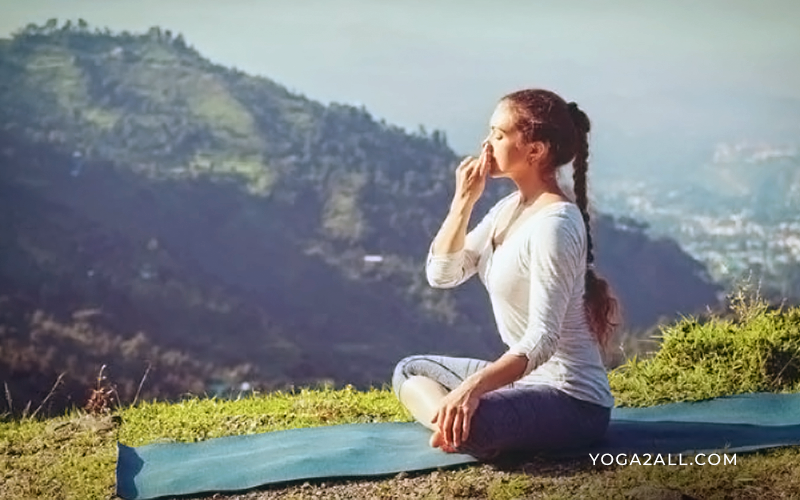Pranayama consists of two words Prana (life) on the breath and Ayama (to draw out). We can say this is a breath exercise or breathing exercise. It is associated with a particular system of breath control with three processes.
- Purak (To take the breath inside)
- Kumbhak (To retain it)
- Rechak (To discharge it from the body)
These are not only models available in Pranayama, but also processes. Some other models also available, and those are widely accepted.
According to Bhagavad Gita (Song of the lord), Pranayama is induced by stopping all breathing. Patanjali, a Hindu Rishi also discussed some specific approach of breathing exercise. He described Pranayama is an essential exercise for concentration. Many Yoga teachers advise Pranayama is an overall practice for the breathing exercise.

Patanjali’s Yoga Sutra, defines, ‘Pranayama’ is the fourth ‘limb’ of the light limbs of Astanga Yoga’. In short, Pranayama is the control of life – currents through the control of breath. Pranayam is essential for spiritual progress.
Many people think ancient India is the origins of pranayama. According to yoga, many different energy channels are present in human body, and pranayama cleanses all the energy channels. There are many benefits of Pranayama. It is beneficial for calmness of mind by regulating the flow of clean air/prana in the body. Because pure oxygen is important for our human body, by breathing practices/pranayama purifies the whole body and helps to increase the overall health of life.
Few Benefits of Pranayama I Benefits of Breathing Exercise I Benefits of Breath Control
- It improves resistance power of the body.
- It is very much useful for respiratory disorders.
- Pranayama improves concentration.
- It helps prevent sleeping disorder and much more.
- It is beneficial for sound mind and healthy living.
- It is beneficial for calmness of mind by regulating the flow of clean air/prana in the body.
- Many researchers reported that ‘Pranayama’ is beneficial in treating different stress-related disorders.
- It improves autonomic function, which is helpful for asthma.
- It also improves a steady mind, sound judgment, and strong will power.
- It enhances perception. But it should be practiced with care and the guidance of a pranayama teacher.
- Pranayama can cure various diseases, like diabetes, obesity, depression, hypertension and digestion.
- It is good for piles, kidney related problem, urinary disease and heart diseases.
- It is good for memory and concentration, stress, immune systems disorders and constipation.
- Pranayama is good for bone joint pain and arthritis.

Types of Pranayama I Types of Breath Control I Types of Breathing Exercises
Pranayama – Breathing Control has many different types. The types of pranayama are responsible for various pranic activities in human body and mind, such as Prana, Apana, Vyan, Udana and Samana. Prana and Upana are very important. Some important Prayanama are mentioned below:
It is an ancient practice concerned with breathing control or breathing exercise. Studies revealed that breathing exercises can relieve symptoms of asthma. It is also beneficial for stress relief, such as anxiety and depression. But many experts consider, there are total six types of pranayama or breathing practice, one should practice to get the overall benefits.
| Anulom – Viloma | Cooling Breathing | Right Nostril Breathing |
| Alternate Nostril Breathing | Digra Pranayama | Suryan Bhedan |
| Agnisar Pranayama | Deep breathing | Shitali Pranayama |
| Agni Prasana Pranayama | Equal Breathing | Shitkari Pranayama |
| Bhastrika Pranayama | Fast breathing | Sama Vritti Pranayama |
| Bhramari Pranayama | Kapalbhati Pranayama | Single Nostril Breathing |
| Bee Breathing | Left Nostril Breathing | Ujjayi Pranayama |
| Bahya Pranayama | Nadi Sodhan | Udgeeth Pranayama |
| Breath of Fire | Ocean Breathing | |
| Chanting Pranayama | Pranayama for Hata Yoga | |
| Chandra Bhedana Pranayama | Quit Breathing |
Pranayama can be classified into three categories. Inferior (Adhama) Pranayama, Middle (Madhyama) Pranayama and Superior (Uttama) Pranayama. The inferior Breathing Exercise consists of twelve mantras, the middle breathing exercise consists of twenty-four mantras and the superior breathing exercise consists of thirty-two mantras.

